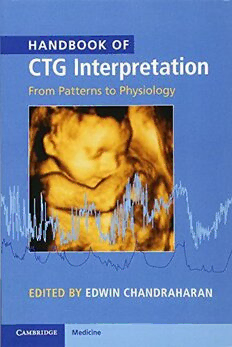
Handbook of CTG Interpretation: From Patterns to Physiology PDF
Preview Handbook of CTG Interpretation: From Patterns to Physiology
HANDBO O K O F CTG INTERPRETATIO N H ANDB OOK OF CTG I NT ER P R ETAT I ON From Patterns to Physiology Edited by Edwin Chandraharan St George’s University Hospitals NHS Foundation Trust, London, and St George’s University of London, UK University Printing House, Cambridge CB2 8BS, United Kingdom Cambridge University Press is part of the University of Cambridge. It furthers the University’s mission by disseminating knowledge in the pursuit of education, learning and research at the highest international levels of excellence. www.cambridge.org Information on this title: www.cambridge.org/9781107485501 © Cambridge University Press 2017 This publication is in copyright. Subject to statutory exception and to the provisions of relevant collective licensing agreements, no reproduction of any part may take place without the written permission of Cambridge University Press. First published 2017 Printed in the United Kingdom by TJ International Ltd. Padstow Cornwall A catalogue record for this publication is available from the British Library Library of Congress Cataloging-in-Publication data Names: Chandraharan, Edwin, editor. Title: Handbook of CTG interpretation: from patterns to physiology / edited by Edwin Chandraharan. Description: Cambridge, United Kingdom; New York: Cambridge University Press, [2017] | Includes bibliographical references and index. Identifiers: LCCN 2016047896 | ISBN 9781107485501 (pbk.) Subjects: | MESH: Cardiotocography | Fetal Hypoxia – prevention & control | Fetal Heart – physiology | Uterine Monitoring – methods Classification: LCC RG618 | NLM WQ 209 | DDC 618.3261–dc23 LC record available at https://lccn.loc.gov/2016047896 ISBN 978-1-107-48550-1 Paperback Cambridge University Press has no responsibility for the persistence or accuracy of URLs for external or third-party internet websites referred to in this publication, and does not guarantee that any content on such websites is, or will remain, accurate or appropriate. Every effort has been made in preparing this book to provide accurate and up-to-date information which is in accord with accepted standards and practice at the time of publication. Although case histories are drawn from actual cases, every effort has been made to disguise the identities of the individuals involved. Nevertheless, the authors, editors and publishers can make no warranties that the information contained herein is totally free from error, not least because clinical standards are constantly changing through research and regulation. The authors, editors and publishers therefore disclaim all liability for direct or consequential damages resulting from the use of material contained in this book. Readers are strongly advised to pay careful attention to information provided by the manufacturer of any drugs or equipment that they plan to use. Dedicated to all babies who have sustained intrapartum hypoxic injuries and to all healthcare providers who are focussed on reflective practice and To my teachers who inspired me to develop an interest in human physiology and intrapartum care Contents List of Contributors Preface Acknowledgements Glossary 1 ‘An Eye Opener’: Perils of CTG Misinterpretation: Lessons from Confidential Enquiries and Medico-legal Cases Edwin Chandraharan 2 Fetal Oxygenation Anna Gracia-Perez-Bonfils and Edwin Chandraharan 3 Physiology of Fetal Heart Rate Control and Types of Intrapartum Hypoxia Anna Gracia-Perez-Bonfils and Edwin Chandraharan 4 Understanding the CTG: Technical Aspects Harriet Stevenson and Edwin Chandraharan 5 Applying Fetal Physiology to Interpret CTG Traces: Predicting the NEXT Change Edwin Chandraharan 6 Avoiding Errors: Maternal Heart Rate Sophie Eleanor Kay and Edwin Chandraharan 7 Antenatal Cardiotocography Francesco D’Antonio and Amar Bhide 8 Intermittent (Intelligent) Auscultation in the Low-Risk Setting Virginia Lowe and Abigail Archer 9 Current Scientific Evidence on CTG Ana Piñas Carrillo and Edwin Chandraharan 10 Role of Uterine Contractions and Intrapartum Reoxygenation Ratio Sadia Muhammad and Edwin Chandraharan 11 Intrapartum Monitoring of a Preterm Fetus Ana Piñas Carrillo and Edwin Chandraharan 12 Role of Chorioamnionitis and Infection Jessica Moore and Edwin Chandraharan 13 Meconium: Why Is It Harmful? Nirmala Chandrasekaran and Leonie Penna 14 Intrapartum Bleeding Edwin Chandraharan 15 Labour with a Uterine Scar: The Role of CTG Ana Piñas Carrillo and Edwin Chandraharan 16 Impact of Maternal Environment on Fetal Heart Rate Ayona Wijemanne and Edwin Chandraharan 17 Use of CTG with Induction and Augmentation of Labour Ana Piñas Carrillo and Edwin Chandraharan 18 Recognition of Chronic Hypoxia and the Preterminal Cardiotocograph Austin Ugwumadu 19 Unusual Fetal Heart Rate Patterns: Sinusoidal and Saltatory Patterns Madhusree Ghosh and Edwin Chandraharan 20 Intrauterine Resuscitation Abigail Spring and Edwin Chandraharan 21 Management of Prolonged Decelerations and Bradycardia Rosemary Townsend and Edwin Chandraharan 22 ST-Analyser (STAN): Principles and Physiology Ana Piñas Carrillo and Edwin Chandraharan 23 ST-Analyser: Case Examples and Pitfalls Ana Piñas Carrillo and Edwin Chandraharan 24 Role of a Computerized CTG Sabrina Kuah and Geoff Matthews 25 Peripheral Tests of Fetal Well-being Charis Mills and Edwin Chandraharan 26 Operative Interventions for Fetal Compromise Mary Catherine Tolcher and Kyle D. Traynor 27 Nonhypoxic Causes of CTG Changes Dovilé Kalvinskaité and Edwin Chandraharan 28 Neonatal Implications of Intrapartum Fetal Hypoxia Justin Richards 29 Role of the Anaesthetist in the Management of Fetal Compromise during Labour Anuji Amarasekara and Anthony Addei 30 Medico-legal Issues with CTG K. Muhunthan and Sabaratnam Arulkumaran 31 Ensuring Competency in Intrapartum Fetal Monitoring: The Role of GIMS Virginia Lowe and Edwin Chandraharan 32 Physiology-Based CTG Training: Does It Really Matter? Sara Ledger and Edwin Chandraharan Appendix: Rational Use of FIGO Guidelines in Clinical Practice Answers to Exercises Index
